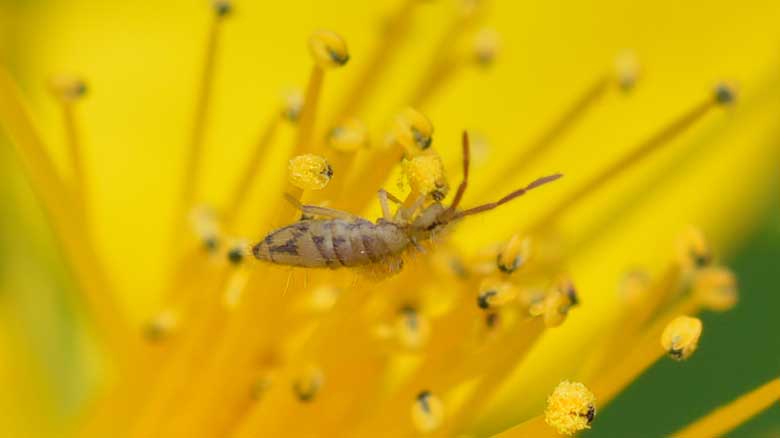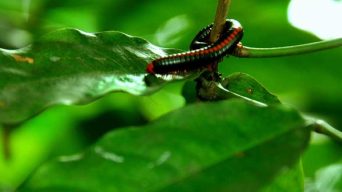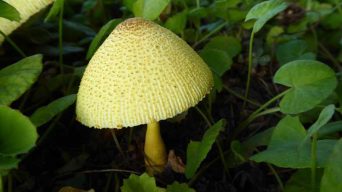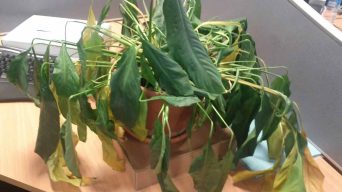To eliminate springtails in houseplants, remove standing water, maintain dry conditions, improve air circulation, and eliminate food sources. Use diatomaceous earth, insecticidal soap, neem oil, or a cedar oil spray. Introduce beneficial predators like nematodes or predatory mites. Consider changing potting soil and prevent infestations by checking plants, keeping them clean, avoiding overwatering, using well-draining soil, and maintaining good ventilation. Follow these tips for healthy, pest-free indoor plants.
Springtails are tiny, harmless insects that can be a nuisance in the home.
They often enter homes through cracks and crevices near windows or doors and can be found in moist areas like the kitchen or bathroom.
While they do not bite or sting, they can be a nuisance because they can quickly infest your home.
You may have a springtail infestation if you have noticed tiny white insects jumping around your houseplants.
Here is an easy guide on how to get rid of springtails in houseplants and keep your home free of these plant pests.
Are Springtails Harmful for Houseplants?
Springtails are small, wingless insects often found near sources of excess moisture.
While they do not cause much harm to plants, springtails may damage plant roots if they are present in large numbers.
While they are not known to transmit diseases, they can become a nuisance for indoor gardeners if their numbers get out of control.
The main problem with springtails is their ability to reproduce quickly and infest your home in large numbers.
This can be a problem if houseplants are kept in humid conditions, as springtails, attracted to moisture, may create an environment conducive to the growth of fungi.
While they do not harm humans or animals, some people don’t want them in their homes.
They are unsightly and can be challenging to remove once they’ve taken up residence in your potting mix.
Identifying Springtail Infestations in Houseplants
The first step in getting rid of springtail bugs is to confirm that your houseplant has an infestation.
Springtails are very small, ranging in size from 1-2mm.
Its color can be anything from white to brownish-grey, and they have a cylindrical shape.
One of the most distinguishing features of springtails is their forked “tail,” which allows them to jump long distances.
If you suspect your houseplant has an infestation, there are simple ways to confirm this.
The first is to look at the potting mix or soil around your plant.
These insects will often congregate in these areas since they are attracted to moisture, creating an environment that can also be conducive to fungi growth.
If you see any small white insects jumping around, you likely have an infestation.
Another way to confirm that your houseplant has an infestation is to place a piece of tape or cardboard over the potting mix.
Check the tape or cardboard after a few hours.
If you see any tiny white bugs on the tape or cardboard, this indicates that you have springtails in your potting mix.
Another way to tell if your houseplants have pests is by their damage.
While they don’t eat plants, springtails can cause damage by chewing on plant roots.
This can stunt the growth of your plants or cause them to wilt.
If you suspect your potted plants have root damage, check the roots for small white insects.
If you see any, this is a good indicator of springtails in your soil.
Understanding the Presence of Springtails in Houseplants
There are a few reasons why your houseplants may have springtails.
The most likely reason is that they came into your home through cracks or crevices near doors or windows.
These pests are often found in damp, moist areas and are attracted to humid conditions.
If you keep houseplants in humid conditions, they may be more likely to get springtails.
Another reason why your houseplants may have these insects is if you’ve recently brought new plants into your home.
Springtails can sometimes hitch a ride on new plants and be introduced to your home that way.
It’s important to inspect any new plants before bringing them inside to ensure they don’t have any pests.
The last reason your houseplants may have springtails is that they are already in your potting mix.
If you’ve recently purchased potting mix or soil, it may already have pests.
This is more common than you might think and is why it’s so important to inspect new plants before bringing them into your home.
Effective Methods to Eliminate Springtails
Once you’ve confirmed that your houseplants have springtails, you must remove them.
There are a few different methods to get rid of springtails.
Regardless of the method used, it is essential to quarantine the affected indoor plant to prevent the pests from spreading to other plants.
Below are some of the most effective methods for getting rid of springtails in houseplants:
1. Remove Standing Water in Your Home
Springtails are attracted to moisture and will often congregate in areas where there is standing water.
If you have any plant trays, saucers, or other water containers, empty them and remove the water.
Also, check around your home for any leaks or spots where water might be pooling and fix them.
Removing standing water will make your home less attractive to springtails and other houseplant pests.
2. Maintain Dry Conditions Around Your Plants
As we mentioned earlier, springtails are attracted to moist conditions.
If your plants are too wet, they may be more likely to get springtails.
Be sure only to water your plants when the potting mix is dry.
Also, consider using a moisture meter to help you monitor the moisture level of your potting mix.
If you live in a humid climate, you may need to water your plants less often to prevent them from getting too wet.
3. Improve Air Circulation for Houseplants
Increasing air circulation is another way to prevent your plants from getting too wet.
If your plants are kept in an enclosed space, the air may not circulate well, which can lead to humid conditions.
It’s crucial to consider moving your plants to a more open area, opening windows, or using a fan to help circulate the air around them. This not only prevents excessive moisture but also regulates humidity levels.
By increasing air circulation, you will help keep the potting mix dry, making it less attractive to springtails.
4. Eliminate Potential Food Sources for Springtails
Springtails are attracted to algae, fungi, and decaying organic matter.
Remove dead leaves and debris from your plants to eliminate potential breeding grounds for pests.
Stay vigilant in checking the soil for springtail eggs, promptly removing them to control their population and maintain a healthy plant environment.
This will also help keep the potting mix clean and dry and make it less attractive to pests.
You should also avoid using too much fertilizer, which can sometimes lead to decaying organic material.
If you use fertilizer, follow the instructions on the package and only use the recommended amount.
Removing food sources will help keep the potting mix clean, making it less attractive to pests.
5. Apply Diatomaceous Earth as a Control Measure
Diatomaceous earth is a natural product that can be used to control springtails.
It works by absorbing the oils and fats from the exoskeleton of the springtail, which causes them to dehydrate and die.
To use diatomaceous earth, sprinkle it around the base of the plant.
Add it to the potting mix if you already have infested plants.
Be sure to reapply it after each watering.
Diatomaceous earth is a safe and effective way to eliminate pests in houseplants.
6. Use Insecticidal Soap for Springtail Eradication
Insecticidal soap is another effective way to control springtails in houseplants.
It works by causing the springtails to suffocate and die.
To use insecticidal soap, mix it with water according to the instructions on the package.
Spray it onto the affected plant, covering all of the surfaces. Be sure to reapply it after each watering.
Pests in houseplants may be easily killed with insecticidal soap.
7. Create a Neem Oil Solution
Neem oil is a natural insecticide that can be used for pest control to kill springtails.
It works by causing the pests to suffocate and die.
Mix neem oil and water and spray it around your plants.
The oil will get rid of any springtails that come into contact with it.
Just make sure to reapply it after each watering.
8. Combine Diatomaceous Earth with Neem Oil
You can mix diatomaceous earth and neem oil for an extra-strength solution.
This mixture will get rid of any springtails that come into contact with it.
To use this mixture, mix equal parts diatomaceous earth and neem oil and sprinkle it around the base of your plants.
This mixture can be added to the potting mix if you have already infested plants.
Reapply as necessary after each watering.
This mixture of diatomaceous earth and neem oil is an effective way to control an infestation in houseplants.
9. Apply Cedar Essential Oil as a Natural Repellent
Cedar essential oil is another natural substance that can kill springtails.
Add a few drops of cedar oil to a spray bottle filled with water and spritz it around your plants.
Cedar oil will get rid of any bugs that come into contact with it.
You can add a few drops of cedar oil to a cotton ball and place it near places where you’ve seen springtails.
The oil will get rid of these pests and prevent them from returning.
10. Introduce Beneficial Predators to Combat Springtails
Another way to control springtail infestations is to introduce beneficial predators into your home.
Nematodes are tiny parasitic worms that can be used to kill springtails.
To use nematodes, mix them with water and then pour them over the soil of infested plants.
The worms will then enter the houseplant soil and get rid of these insects.
You can also use predatory mites to get rid of an infestation.
Predatory mites are tiny mites that feed on other smaller insects, including springtails.
To use predatory mites, release them into the soil of infested plants.
The mites will then begin to search for and eat the springtails.
11. Consider Changing the Potting Soil
If you have potted plants infested with springtails, you may need to change the potting soil.
Remove the plant from its pot and discard the old potting mix.
Then, add a new soil and replant the plant.
Be sure to remove any dead leaves or stems from the plant before replanting it.
You may also need to repot the plant if the infestation is severe.
If you do this, be sure to sterilize the pot and tools you use to prevent the spread of the infestation.
Preventing Springtails In Potted Plants
Indoor plants are a great way to add some greenery to your home. But they can also be a source of pests.
It’s essential to prevent springtails in your houseplants to keep them healthy and free of pests.
Here are 7 tips for preventing springtails in potted plants:
- Check plants before bringing them inside. Springtails often hitch a ride on plants that are brought inside from outside. Inspect your plants thoroughly before bringing them into your home to ensure they’re not infested.
- Keep plants clean. Springtails are attracted to dirty surfaces. Keep your plants clean by wiping them down with a damp cloth.
- Avoid overwatering. Overwatering is one of the most common ways that springtails get into houseplants. Water your plants only when needed and allow the soil to dry out between waterings.
- Use well-draining soil. Springtails are attracted to damp, poorly draining soils. Use a well-draining potting mix for your plants and ensure drainage holes in the bottom of the pots.
- Don’t let plants sit in water. After watering, remove any excess water from the saucer or tray beneath the pot. This will help to keep the plant soil from becoming too wet.
- Don’t let plants sit in damp areas. Springtails are also attracted to humid places. Keep your plants away from basements, humidifiers, windows, and other moist areas.
- Keep your home ventilated. Good air circulation will help to keep springtails away from your plants. Open windows and use fans to circulate the air in your home.
Final Thoughts
Indoor potted plants are a great way to spruce up your home and bring a touch of nature indoors. However, they can be susceptible to pests, such as springtails.
Although springtails don’t usually cause harm to plants, they can be a nuisance, potentially affecting the overall aesthetics of your indoor gardening space.
The good news is that there are several things you can do to prevent and get rid of these insects in your houseplants, ensuring a thriving and pest-free environment for your indoor gardening endeavors.
Following the tips above, you can keep your plants healthy and your indoor gardening experience enjoyable, free from the interference of unwanted pests.







